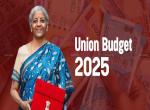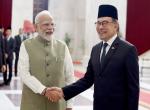Less than two years ago, when the world was still staggering under the load of severe economic recession, India was being cited as a fine example of continuous economic growth in a totally democratic environment, lauded for its management of the economy and its banking system, with a corporate sector which was optimistic about India and its future.
Suddenly towards the latter half of 2010 the economy started falling apart with scandal after scandal emerging in the matter of the Commonwealth Games, allocation of 2G Spectrum, illegal mining in Karnataka and Andhra Pradesh, falling production and a corporate sector in near panic. From the confident and strong rupee of just one year ago it has now slipped down to nearly Rs.56 against the dollar. Suddenly the budget deficit has grown because of huge outlay on the very schemes like the National Rural Employment Guarantee Scheme, which were the flagships of UPA-II. Government heeded none of the warnings that conservative economists and experienced administrators were sounding. These people were brushed aside as Cassandras or, worse still, being positively anti-national and anti-UPA.
It is a fact of which we must take notice that India is governed by a coalition in which the lead party, the Congress, has to do a balancing act in order to keep together its heterogeneous flock of supporters. In the UPA-I version the Congress had to largely contend with the Left, which behaved in a fairly responsible manner even after it quit the coalition over the Indo-U.S. Nuclear Agreement. In its second birth UPA found that the Left was virtually wiped out in Parliament, that DMK and Trinamool Congress had a fairly commanding role and Mulayam Singh Yadav and Mayawati also had to be kept sweetened. Atal Bihari Vajpayee also handled a heterogeneous coalition but he had diplomatic skills which the leaders of the present government seem to lack. Therefore, despite some strange compromises, the Vajpayee government never totally lost control of the situation. That does not seem to be the case with the present government, despite the fact that people like Lalu Prasad Yadav have been marginalized in the elections. This has led to some totally unacceptable situations and compromises which have seriously affected the credibility of government, severely hampered its ability to take decisions and created an environment in which there is seeming paralysis of government.
The functioning of the government is being affected by several factors. The first is that there is a National Advisory Council headed by a person recognised as the head of the United Progressive Alliance, Mrs. Sonia Gandhi, who also happens to be the Congress President. In many matters NAC functions as a parallel government or at least the supreme policy making body. This is reminiscent of the Soviet Union where Stalin, the Secretary General of the Communist Party of the Soviet Union, was the de facto ruler and the President and Prime Minister were figureheads who took and obeyed orders. There is uncertainty in UPA whether decision making even in trivial postings and transfers vests in Sonia Gandhi or whether the Prime Minister has the final say. Obviously Sonia Gandhi is larger than life because in matters such as the Right to Education, Food Security, NREGS etc., it is NAC which calls the shots. Even in the matter of appoint of the Principal Secretary to the Prime Minister, it is likely that Pulok Chatterjee, who has been with Sonia Gandhi ever since he was a young Deputy Secretary to Government, is her choice and that the Prime Minister has not even had the freedom to appoint his own personal staff. If that be true real power in government lies outside the Prime Minister’s office and the Council of Ministers and this is a very dangerous thing in a parliamentary democracy. Such an arrangement can only lead to ad hocism and, ultimately, paralysis.
An essay of this nature has naturally to be divided into different sections or sectors because government can be homogenous but it is not monolithic. Let us begin with the politics of coalition. The magic figure for a majority in Parliament is 272, which is one more than the half way mark. If a party has approximately 182 to 200 seats it would have to collect anything between 75 and 100 additional supporters. This would be relatively easy because the smaller parties tend to go along with that party which has the largest number of seats and which number is viable. In the 15th Lok Sabha, that is, the current House, the Congress has 206 seats, about double the number that the next largest party, BJP, has. It is true that unlike the UPA where the largest single chunk of support for the Congress came from the Left Front, in the present House the support to the Congress is very heterogeneous, with DMK, Trinamool Congress and Lalu Prasad Yadav’s miniscule Janata Lok Dal being the main supporters. The Samajwadi Party of Mulayam Singh Yadav has selectively supported UPA, as also has Mayawati’s Bahujan Samaj Party. In the Rajya Sabha, however, the situation is different because there BJP has a substantial presence and the UPA does not command a majority. That is one reason why the Lokpal Bill has been deadlocked conveniently because perhaps the Congress never wanted it to be enacted. It is not understood why the provisions of Article 108 of the Constitution have not been invoked and a joint sitting of both Houses of Parliament has not been arranged so that, if possible, the Bill can be passed despite opposition in the Rajya Sabha. Perhaps this is indicative of the lack of will of the ruling coalition to pass the Bill, an allegation which the supporters of Anna Hazare have been making from time to time.
To return to the issue of the coalition, the whole of 2010 and much of 2011, not to mention the first half of 2012, have passed with so many compromises being made that one could be excused for feeling that government has been stuck by paralysis of decision making. A few examples will suffice to illustrate the point. In the allocation of 2 G Spectrum for mobile telephony government (it is irrelevant whether it was NDA or UPA because government is a continuing body) decided that in order to encourage mobile telephony the largest number of players possible would be invited to invest in the sector. Here entry was by invitation and the fees were fixed. At that stage the telephone industry in India was in its infancy and mobile telephony was virtually unknown. As the field was thrown open investors flooded in and soon India became the fast growing mobile telephony country in the world. This naturally attracted more players and high value began to be attached to spectrum allocation, for which formerly there were no takers. This is the stage at which government should have taken a fresh look at its policy and switch from allocation by invitation on a fixed rate to a system of auction or tenders. Unfortunately DMK had claimed the very fertile communication sector as its fiefdom and one DMK Minister succeeded another as the minister in charge. It is in this scenario that A. Raja became the minister.
The procedure in government is that in any matter of policy, or in which there are financial implication, or interdepartmental coordination the Rules of Business of the Executive Government make it mandatory for the matter to be brought before the Council of Ministers for its decision. In the case of telecommunications A. Raja avoided going to the cabinet and on his own, by suitably twisting the policy around, allotted spectrum at will and on fixed rates. This has caused enormous loss to government, estimated by the Comptroller and Auditor General as being as high as Rs. 1, 76,000 crores. Even if we accept this as speculative and grossly exaggerated, the fact is that A. Raja caused substantial loss of revenue to government by his arbitrary decisions. The Secretary of the Ministry, who is responsible for the proper implementation of the Rules of Business, failed in his duty by refusing to issue orders without a Council decision. The Prime Minister was aware of what was going on but turned a blind eye. When the whole affair blew up in his face the excuse touted out was of helplessness in the face of compulsions of the coalition. A coalition which permits wholesale corruption and pleads the compulsions of coalition as an excuse is no coalition – it is only a collective of dishonest gangsters out to loot the people. A Prime Minister who, or a party which, pleads helplessness under these circumstances can only be accused of paralysis.
A second example is that of a railway budget 2012-13. Here, too, the Trinamool Congress and its Feuhrerin, Mamata Banerjee, claimed the railways as their jagir and the Prime Minister, who alone is empowered to decide portfolios of ministers, acquiesced. The minister, Dinesh Trivedi, presented the 2012-13 railway budget to Parliament, presumably after it had been cleared by the Council of Ministers. A furious Mamata Banerjee immediately asked for his head and condemned the budget as unacceptable. The Prime Minister readily succumbed, Dinesh Trivedi has to go and his successor, Mukul Roy, rejected his ministry’s own budget and presented a new budget to Parliament. Where was the collective responsibility of the Council of Ministers which is mandated by Article 75 (3) of the Constitution? Only a paralysed party and government can permit this to happen.
Let us move from politics to the politico-economic arena. Ever since UPA-II came to power there has been public outcry against increasing inflation and a slow down of the economy. There are many reasons for inflation and one is that money is pumped into the market without there being commensurate increase in production and availability of goods. India embarked on an ambitious scheme of guaranteed rural employment, for which purpose the Mahatma Gandhi National Rural Employment Guarantee Act was passed by Parliament and the National Rural Employment Guarantee Scheme was placed under it. The Act and the scheme have both emanated from the National Advisory Council. This is a demand based programme in which if there is a demand for employment in rural areas government, by law, is required to provide one hundred days per year employment per family. It has degenerated into a job creation programme in which creation of assets is secondary and giving of wage for employment becomes primary. When we compare this with previous programmes like the Watershed Management Programme we find that those programmes had the creation of specific assets as the objective and, because they are rural assets, village employment was automatically created. Because the asset was permanent the villagers had a commitment to its creation and, therefore, the Watershed Management Programme has by and large been a success, especially in drought prone areas. The present programme only aims at putting one hundred days wages into the pocket of a villager without necessarily creating assets. It is a muster based programme and I can state with great confidence that no muster based programme can be run honestly in India. There is a great deal of corruption in the programme and more money is going into the pockets of individuals, who are not necessarily village beneficiaries. Had the programme been aimed at 100 percent asset creation its long-term effect would not be inflationary, but because the present programme is putting a little additional money into the pockets of those who need it and a great deal of money in a few pockets which would be dipped into for conspicuous consumption, there is an inbuilt inflationary pressure.
Another reason for inflation is programmes of giving subsidies where none are called for. In Madhya Pradesh government is buying, on guarantee of 100 percent purchase, wheat from farmers at a rate which is at least Rs. 350 per quintal more than the prevailing market rate. Is this subsidy really needed? Almost every State gives subsidised electricity to villagers, whose demand is for guaranteed supply rather than for a subsidy. Gujarat is one of the few States, perhaps the only one, where rural power supply is guaranteed, for which the villagers have to pay. The Electricity Board is flush with funds because people pay, the system is properly maintained and enlarged so that the quality of power is constant and both villagers and government have benefited. Where subsidies are really needed is for the totally indigent, the under-nourished children and the social unfortunates facing starvation. To that extent the schemes of cheap grain introduced by Tamil Nadu and Andhra Pradesh are examples of properly applied subsidies. Free power is an example of a subsidy being wasted. Government is either totally incompetent, is paralysed or is petrified because of misplaced populism to be able to take an objective view of the subsidy regime. By an objective view I do not mean the myopic vision of the World Bank trained economists like Montek Singh Ahluwalia and the neo-liberals, who have no clue about how the poor in this country live. Nor does this include the jhola brigade which seems to dominate in NAC. I refer here to a holistic view being taken by people who understand India, are in sympathy with the average citizen, but who also understand the economics of subsidy versus full payment for a beneficial service, who understand budgeting and who are prepared to look at priorities.
Neo-liberals say that all State intervention is bad and the private sector should be given a free rein. They point to Air India as a horrible example of public sector mismanagement. What about Kingfisher Airlines, the erstwhile Sahara Airlines and Jet Airways? Are they better managed than the public sector? A paralysed government failed to regulate the private sector or give that kind of autonomy to the public sector which would permit it to compete in the market. What we need is a set of priorities about the sectors in which government will directly intervene and those in which its intervention will be regulatory. A competent government would set up an economic regime in which the market operates in a rational manner, it would not be allowed to disrupt the economy because of its own selfish interests but would otherwise be facilitated to grow and prosper. A purposive government would shed public sector flab and prepare the ground rules for how the public sector will function. A purposive government would have policies which encourage growth without necessarily reducing India to a kind of off-shore manufacturing facility for western industries, which has happened in parts of China, Taiwan and South Korea. A purposive government would encourage the growth of the secondary sector and facilitate the primary sector of agriculture to increase production, improve connectivity to market, encourage industry which would add value to agricultural products and generally connect the producer with the consumer through an active market. Are any of these happening? The answer is an emphatic NO.
Ultimately a government functions at two levels, policy and administration. The two are extremely sensitive to each other because if there is uncertainly in policy making administration can never be either firm or competent. A good administration requires a political system which functions according to ideology and programmes and is not totally overpowered by populism and immediate expediency. After all, the administration also requires the existence of a policy. First and foremost the civil servants who are required to administer must not only have a policy frame to follow – they should be confident that if they implement policy they will be supported. In the absence of clear-cut policy civil servants dither and if the situation worsens, they go into a coma of inaction. In India we have built up a culture of civil servants never taking decisions but passing the file from desk to desk till the matter dies a natural death. I remember a former Defence Secretary who took pride in the fact that during his tenure there was not a single scandal because he did not allow the armed forces to purchase even a rifle bullet. Meanwhile the Army has been reduced to a state where the current Chief of Army Staff has assessed that the Army is incapable of fighting a sustained war. This is a complete negation of government. Taking the defence example, it has taken more than twenty years to select fighter aircraft for the Indian Air Force and even now there is no guarantee that some obscure allegation of wrongdoing will not torpedo the whole effort. The Indian Army is deprived of artillery pieces because every time a gun is to be purchased someone alleges corruption. Can we not work out a system by which once the armed forces, through a rigorous exercise, are able to convince government about the need for a particular weapon system, sanction is issued, the budget released and the process of procurement completed with reasonable speed? The parameters of purchase must be clearly defined by government and the process, considering the security requirements, should be as open as possible. The committee in charge of purchase should have complete powers to take a decision, provided that the reason for decision is recorded in extenso and the justifications are clearly given. Unless there is genuine reason to believe that there is widespread corruption or action contrary to the national interest, government must not allow interference with the process of procurement. The price of delaying the process can be defeat in a war which would be disastrous for the country.
Our civil servants have to be given respect as the first step towards building their morale. Under Articles 53 and 154 the executive power of the Union or a State will vest in the President and Governor respectively, but will be exercised through officers subordinate to him. The word used is ‘officers’, not ‘babus’. The constant derogatory reference to civil servants as babus has sapped their morale and this has been detrimental to their ability to take decisions. Officers have certain powers under law and the Rules of Business. It must be ingrained in them that they will obey the law and in this they will not deterred by pressure, official, political or popular. If we are able to restore a situation in which officers work according to rules and according to the law and resist undue pressure, the administration will fall in line and work will begin to run smoothly.
In order that officers function well they have to be competent and it is the purpose of training to improve the competence level of officers. A competent officer working according to rules, unswayed by pressure will also be decisive and this in itself will cure the paralysis of government. Such officers have to be protected because a competent officer who functions according to rules is bound to be honest because the rules do not permit dishonesty. Unfortunately it is these very officers who become the first target of scoundrels who are trying to derail government and, therefore, government must make it clear that these officers will find the protection of a proactive government which is keen to do its duty to the people.
To conclude, the Constitution and the law both aim at giving India a positive government. Populism, which is the biggest enemy of good government, has unfortunately made government incompetent, this incompetence has advanced and there are signs that paralysis is leading to petrifaction. A petrified government cannot give to the people what has been mandated in the Preamble to the Constitution: Justice, social, economical and political: Liberty of thought, expression, belief, faith and worship: Equality of status and of opportunity and Fraternity, assuring the dignity of the individual and the unity and integrity of the Nation.
Published Date: 28th May 2012









Post new comment